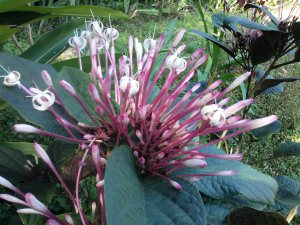 Winter Starburst Clerodendrum in bud
Winter Starburst Clerodendrum in bud
This is my favorite burst of winter color and it has finally bloomed, the cold snap slowed it down, then the rain slowed it down. I have been waiting (somewhat patiently) for the full flower. Here is the next phase:
And finally the full Starburst effect:
The Latin name for this plant is Clerodendrum quadriloculare. This is an interesting group of plants, ranging in size from vines to perennials then shrubs up to small trees. Mostly native to tropical South Asia and with a tendency towards creepy habits you must be careful who among them is invited into your garden. I have seen some gardens overrun by a perennial orange version of Clerodendrum which is beautiful but really creepy.
I am glad to have this shrub in my garden, I think of it as a Tropical Rhododendron, and it is so much easier…
View original post 79 more words




Wow-that is just stunning! I have never seen anything like it. It really is like a starburst….have you ever tried the vireya rhododendrons? They are subtropical plants and would probably do quite well in Florida
LikeLike
Fantastic comment, as usual. I have never heard of those rhododendrons – it appears there might be some in Miami?? At Mr. Fairchild’s personal garden.
My guess is they need the volcanic type of soil, they don’t appear in any of my books about Florida.
LikeLike
Thanks 🙂 a volcanic soil is good, but they really demand free drainage. So on your sandy soils and just add heaps of organic matter and pine needle mulch they should do just fine. I grew them when I lived in Brisbane (almost as warm as S. Florida, and a mix of sand and clay soils – certainly nothing volcanic, as volcanic soils are very rare in Australia).
They are really easy to grow in shady spots (and even in pots if your soil is alkaline) and flower most of the year. I think vireyas are more popular in Australia as there is only a comparatively small part of the country suitable for growing the traditional cool-climate rhododendrons….but if you can, the vireyas are worth looking out for as they are just stunning and trouble-free.
LikeLike
There is nothing, so far, in the literature about them. They sound fabulous. I am taking a class from a Botany professor and will ask him. (The only Rhododendron in the books is obtusum) I can tell you Kurume Azaleas would roll over and die here in the summer.
Pine straw is fairly scarce here as well – what pines provide the mulch there?
LikeLike
Radiata pine is very common in my part of Australia, but in the subtropical areas like Brisbane, loblolly pine and slash pine (both florida natives, I believe) are very common and loblolly has been declared a weed in these areas!
LikeLike
Really? I think the radiatas grow in New England here. We see furniture made from that. I am too far south for Loblollies – it is Slash Pine and Sand Pine here – shredded Cypress bark is the mulch of choice, I think pinestraw would most likely blow away in my garden. I will ask around about the Rhodos.
LikeLiked by 1 person
How very lovely!
LikeLike
Thanks – the Alzheimers article link was great.
LikeLike